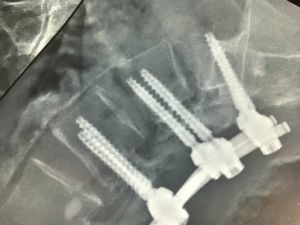Spinal Fusion
Spinal Fusion
A spondylodesis (fusion or stiffening surgery) should always be considered as a last resort, as it is an irreversible surgical intervention.
The affected segment of the spine will be aligned and stiffened (fusion, spondylodesis) simultaneously.

What is spondylodesis?
A scoliosis surgery is a considerable and irreversible intervention. The distorted segment of the spine will be aligned and stiffened (fusion, spondylodesis) simultaneously. The intervention performed either from the front (ventral access) or from the back (dorsal access) – in rare cases both access points will be used concomitantly.
After such a stiffening surgery, other surgical or conservative treatment options are no longer available. It must hence always be regarded as a last resort if all other non-surgical therapeutic methods have failed and if there is no hope that with conservative care there will be any success.
A spondylodesis (fusion or stiffening surgery) should always be considered as a last resort, as it is an irreversible surgical intervention.
The insertion of the screws and bars is done through an incision at the centre line of the back at the level of the affected spine section. If no additional ventral fusion is planned, eventually bone grafts from the iliac crest will be taken and placed at the rear part of the spine. This will further support osseous stiffening.
If an additional ventral support and fusion is planned, the point of entrance will be an incision at the left abdomen. The spinal disk will be removed and replaced by a cage (placeholder made of bone graft, titanium or organic polymer thermoplastics like polyetheretherketones PEEK).
Success rates of such fusion surgeries cited in scientific literature vary. A quote of 85% seems realistic.
Slipped vertebrae (Spondylolysthesis) L5/S1 before surgery
Situation after the surgery. Vertebral bodies are back to alignment.
How is surgery carried out?
The insertion of the screws and bars is done through an incision at the centre line of the back at the level of the affected spine section. If no additional ventral fusion is planned, eventually bone grafts from the iliac crest will be taken and placed at the rear part of the spine. This will further support osseous stiffening.
If an additional ventral support and fusion is planned, the point of entrance will be an incision at the left abdomen. The spinal disk will be removed and replaced by a cage (placeholder made of bone graft, titanium or organic polymer thermoplastics like polyetheretherketones PEEK).
The intervention is done under general anesthesia and takes about two hours. You will be able to walk by yourself already two hours after surgery and you may go back home again after three days.
What post-operative care is necessary?
You will have to carry a specially fitted corset for approximately six weeks and then it is recommended to start an individually targeted and professionally supervised physiotherapy.
When may I resume my sports activities?
After about 12 weeks you should be able to go swimming or to ride your bicycle. You may gradually resume your usual sports activities after 6 to 9 months.
When can I go back to work?
After six weeks you can resume simple office work and slight physical work. You shouldn’t do any hard physical work during the first 8 weeks and then only gradually increase.
What is the success rate?
In the international scientific literature success rates of more than 85% are quoted.
Complete our questionnaire
Complete a more detailed questionnaire and get a FREE No Obligation Consultation.
All Procedures
Spine Procedures
Hip Procedures
Knee Procedures
Shoulder and Elbow Procedures
Foot and Ankle Procedures
Types of Surgeries
Arthroscopy (also called arthroscopic or keyhole surgery) is a minimally invasive surgical procedure on a joint in which an examination and sometimes treatment of damage is performed using an arthroscope, an endoscope that is inserted into the joint through a small incision.
Endoscopic surgery uses scopes going through small incisions or natural body openings in order to diagnose and treat disease. Another popular term is minimally invasive surgery (MIS), which emphasizes that diagnosis and treatments can be done with reduced body cavity invasion.
Open surgery is the traditional type of surgery in which an incision is made using a scalpel. While minimally invasive surgery has become increasingly popular, there are a number of situations in which open surgery is still preferable.
Discover the many reasons to come to Cyprus
Cyprus is a 4.5 hour flight from many UK airports. Find out why Cyprus is a good choice to receive and recover from your Orthopaedic Procedures.
Sign up for a FREE Initial Consultation
Let’s discuss your treatment options.

